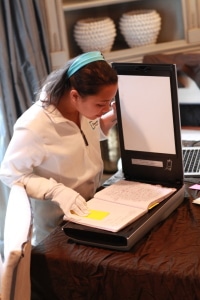By Carol Lyon (Digital Archivist with Doorstep Digital)
In order to digitally archive photos, film, negatives, slides and documents, a computer and a scanner are imperative, but not all scanners are created equal. There are several different types of scanners, including flatbed scanners, sheetfed scanners, and portable scanners. Some scanners are designed for photo scanning, others for documents, and others can handle multiple purposes. It is important to know what kind of scanner you need for your specific archive project.
The most important feature of a scanner is its resolution capabilities. Resolution measures the number of dots per inch (DPI) that a scanner can pick up. The higher the resolution, the clearer and more detailed the captured image will be. 300 to 600 DPI is sufficient for turning documents and printed photos to digital files. Most all-purpose scanners can handle this range. In fact, many multifunction printers have this type of scanner built into them. However, if you want to scan slides or negatives, the average scanner just won’t do. Transferring a small image from a slide to a high quality digital file with print-size dimensions requires a much higher resolution, such as 2,400 DPI or higher! Many flatbed photo scanners have this capability and also come with adapters or holders for film and slides.
Flatbed scanners are one of the most common types of scanners, and they can be a great option for scanning photos and documents as well as for film and slides. They are ideal for old, delicate photos or documents that need to be handled carefully. Also, if an item is especially small, like a wallet photo, or large, like a piece of artwork, flatbed scanners are more likely to accommodate your needs.
But let’s say that you have boxes and boxes of photo albums with photos in good condition that need to be digitally archived. What kind of scanner should you use? You could still rely on the flatbed, but count on hours—maybe even days—of tedium as you put a photo in, scan, take it out, and do the same process over and over again for thousands of images. Some flatbed scanners come with software that can recognize when you are scanning more than one image at once. But even with this feature, you will not be scanning more than three or four photos at a time. As an alternative, you could use a high resolution sheetfed scanner. This type of scanner has an automatic feed tray that allows you to scan image after image without pausing in between each scan. This makes the archiving process go much faster. Some sheetfed scanners also have the capability for one-pass duplex scanning, which scans both sides of an item at once. Think of all those important dates and valuable notes of love written on the back of photos! With one-pass duplex technology, photo album scanning becomes much faster as you scan both the photos and the notes on the back simultaneously.
Some portable scanners can handle scanning photos and documents quickly, too, but before using one of these, you will want to make sure that its resolution capabilities fit your needs. Handheld scanners, for instance, are not designed to capture a quality photo image, so I don’t recommend using this type of scanner for archiving.
After reading this blog, you may decide that one type of scanner will not be able to accommodate all your archiving needs, especially if you have a variety of media to digitize. One will work efficiently with newer photos and documents, but another type entirely is designed to work well with slides, negatives, or delicate items. The good news is that Doorstep Digital Archivists carry several different models of scanners with them when they come to archive your memorabilia. For efficiency, they have a sheetfed scanner with one-pass duplex technology that can scan hundreds of photos and documents in an hour. For delicate items, items in uncommon sizes, slides, and film, the Digital Archivist has flatbed scanners complete with appropriate adapters and holders for each specific item. And, of course, Doorstep Digital scanners use high resolution so that your archived copies are crisp and detailed. We use this variety of scanners so that we can be sure to be your one stop for all your digital archiving needs.
Sources
- Doorstep-Digital.com
- http://printscan.about.com/od/featurestolookfor/tp/Scanner-Types-by-Application.htm


Recent Comments